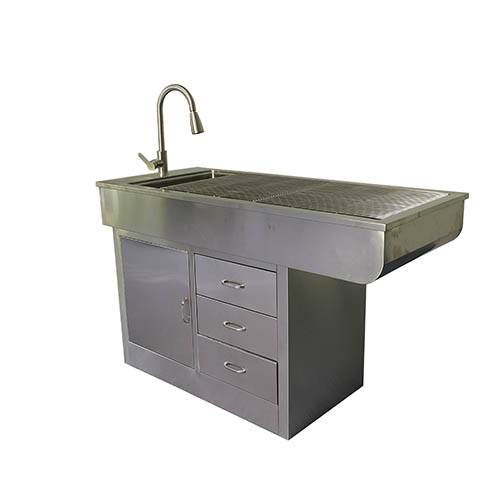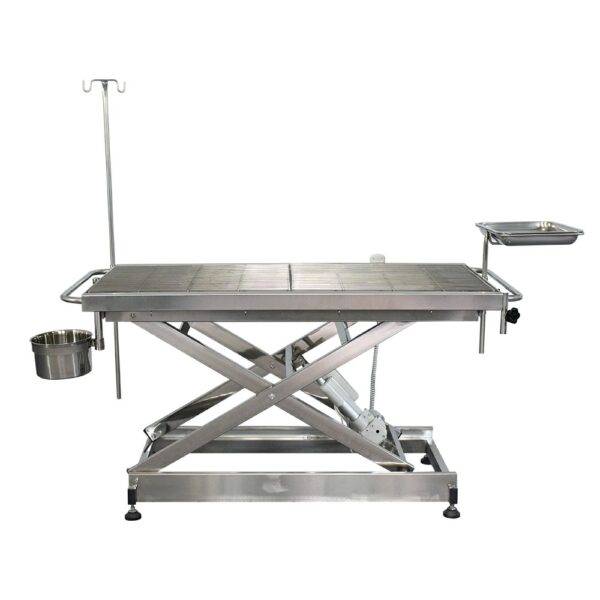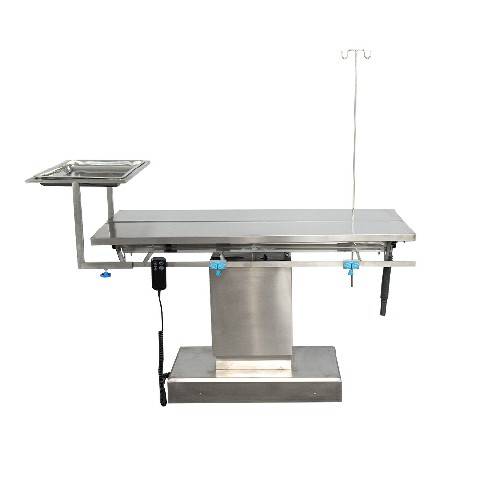Indirizzo
304 Il cardinale nord S.
Dorchester Center, MA 02124
Ore di lavoro
Dal lunedì al venerdì: 7:00 - 19:00
Fine settimana: 10:00 - 17:00

I tavoli operatori veterinari svolgono un ruolo cruciale negli interventi chirurgici sugli animali fornendo ai veterinari una superficie stabile e confortevole per eseguire varie procedure chirurgiche. Con i progressi della medicina veterinaria e gli interventi chirurgici più complessi eseguiti sugli animali domestici, è importante che i tavoli operatori veterinari soddisfino le esigenze sia degli animali che dei professionisti veterinari. Questo post del blog esplorerà le caratteristiche principali e i vantaggi dei tavoli operatori veterinari, risponderà ad alcune domande frequenti e fornirà consigli per la selezione del tavolo operatorio giusto per uno studio veterinario.






I tavoli operatori veterinari sono progettati specificamente per i pazienti animali, con caratteristiche che promuovono sia il benessere degli animali che l'efficienza chirurgica. Ecco alcune delle caratteristiche più importanti:
I tavoli operatori veterinari consentono la regolazione dell'altezza per adattarsi alle esigenze di animali di diverse dimensioni e alla statura del veterinario. La possibilità di alzare o abbassare facilmente l'altezza del tavolo previene lo sforzo e l'affaticamento della schiena del personale veterinario che esegue procedure lunghe. Gli attuatori idraulici o elettrici forniscono regolazioni dell'altezza fluide e precise.
I piani dei tavoli sono generalmente realizzati con materiali durevoli e facili da pulire come l'acciaio inossidabile o i materiali compositi. I design dei piani portapazienti incorporano caratteristiche come bordi arrotondati, aree incassate, supporti di ritenuta e ritagli per l'accesso durante l'intervento chirurgico. Le superfici antiscivolo forniscono stabilità durante le procedure. Sono disponibili anche tavoli riscaldati per mantenere la temperatura corporea del paziente.
I sistemi di ritenuta integrati consentono l'immobilizzazione sicura e umana dei pazienti durante l'intervento chirurgico. Le opzioni comuni includono supporti per arti regolabili, cinghie di sicurezza e maschere per anestesia. Alcuni tavoli offrono restrizioni multiposizionali per adattarsi a varie posizioni e procedure chirurgiche.
I supporti Mayo integrati o collegabili forniscono uno spazio in cui organizzare strumenti e attrezzature chirurgiche a portata di mano. Avere gli strumenti necessari facilmente accessibili semplifica i flussi di lavoro chirurgici.
Oltre alla funzionalità, i tavoli operatori veterinari sottolineano il benessere e la sicurezza degli animali. Caratteristiche come il riscaldamento integrato, il sistema di contenzione delicato e il design ergonomico per i veterinari aiutano a ridurre al minimo lo stress per i pazienti sottoposti a intervento chirurgico. I tavoli stabili e ricchi di funzionalità consentono inoltre risultati chirurgici più sicuri ed efficaci.

I principali vantaggi derivanti dall’utilizzo di un tavolo operatorio veterinario appositamente costruito includono:
La tabella riassume alcune procedure chirurgiche veterinarie comuni e il modo in cui i tavoli operatori possono supportare ciascuna tipologia. Nel complesso, i tavoli speciali sono progettati per semplificare i flussi di lavoro, massimizzare il benessere del paziente e del personale e consentire risultati della massima qualità.
| Tipo di intervento chirurgico | Altezza regolabile | Restrizioni | Accesso chirurgico |
|---|---|---|---|
| Sterilizza | SÌ | SÌ | Laterale e dorsale |
| Neutri | SÌ | SÌ | Ventrale |
| Procedure ortopediche | SÌ | SÌ | Dorsale e laterale |
| Chirurgia dei tessuti molli | SÌ | SÌ | Ventrale e laterale |
| Procedure odontoiatriche | SÌ | SÌ | Ventrale |
Quando si seleziona a tavolo operatorio veterinario, è importante scegliere un prodotto di alta qualità da un produttore esperto con una solida esperienza nel settore veterinario. Cerca un tavolo progettato specificamente per i pazienti animali con caratteristiche che ottimizzano sia la cura degli animali che i flussi di lavoro chirurgici. Considera il tuo budget, le esigenze del carico di lavoro e i vincoli di spazio fisico. Fornitori affidabili possono aiutare nella scelta del modello e della configurazione del tavolo giusti. Un tavolo operatorio veterinario ben progettato e adeguatamente mantenuto svolge un ruolo inestimabile nel sostenere la salute degli animali consentendo cure chirurgiche sicure ed efficaci. Con i progressi della medicina veterinaria, i tavoli operatori continueranno ad evolversi insieme alle esigenze degli animali domestici, dei clienti e dei professionisti veterinari.
Di che dimensioni è necessario il tavolo operatorio?
Le dimensioni del tavolo dipenderanno dalle dimensioni e dal carico di lavoro dello studio veterinario. Come linea guida generale, le tabelle dovrebbero ospitare la razza più grande di animali comunemente trattati. I tavoli mobili o modulari offrono flessibilità.
Come scelgo le opzioni di ritenuta?
Considerare i tipi di interventi chirurgici eseguiti e le dimensioni/razze dei pazienti. Le cinture regolabili e multiposizionali offrono la massima versatilità. Cinture, cinghie e supporti imbottiti per gli arti sono comuni.
Quale materiale per il piano del tavolo è il migliore?
L'acciaio inossidabile e i materiali compositi durevoli come il cloruro di polivinile (PVC) sono facili da pulire e disinfettare. Cerca superfici non porose e non tossiche per facilitare il controllo delle infezioni.
Dovrei prendere un tavolo elettrico o manuale?
I tavoli elettrici consentono regolazioni dell’altezza più fluide e facili ma costano di più. I sistemi a manovella manuale funzionano bene per le esigenze di base se il budget è un problema. Considera il tuo spazio di lavoro fisico e l'ergonomia.
Quanto durerà un tavolo operatorio?
I tavoli di qualità di produttori rinomati durano in genere 10-15 anni con una corretta manutenzione come la disinfezione e la lubrificazione periodiche. Un utilizzo elevato potrebbe richiedere un servizio più frequente.
Che manutenzione è necessaria?
La disinfezione sistematica è fondamentale per prevenire la contaminazione incrociata. Controllare eventuali segni di usura e parti allentate/rotte. Lubrificare i giunti mobili come indicato. Considerare un contratto di assistenza per riparazioni e manutenzione preventiva.
